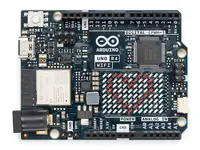From R3 to R4: Discover the new Arduino Uno
Placed onA new milestone in technological evolution has been reached with the launch of the Arduino UNO R4. This powerful new version of the beloved microcontroller is not only a leap forward in computing power and connectivity, but also opens a new chapter in the world of DIY electronics. After thirteen years of the successful Arduino UNO R3, the R4 is here to redefine the way we make, build and innovate.

The new Arduino UNO R4
The Arduino UNO R4 takes maker capabilities to new heights. Equipped with a fast 32-bit Arm® Cortex®-M4, the UNO R4 offers a 16-fold increase in memory and more connectors and connectivity options than ever before. The UNO R4 comes in two variants: the UNO R4 Minima and the UNO R4 WiFI.
Specifications and Features
Both variants of the UNO R4 allow you to easily start creating or upgrade existing UNO R3 projects with more processing power, memory and speed. Some of the notable new features include:
- More memory and faster clock: The UNO R4 can perform more precise calculations and handle more complex and advanced projects than ever thanks to a 16x increase in memory and 3x the clock speed.
- New Built-in Peripherals: These include a 12-bit DAC, CAN BUS, OP AMP and SWD port, each expanding your maker potential and enabling you to tackle increasingly sophisticated projects with ease.
- USB -C Connector: The UNO R4 embraces the smaller, more powerful and more robust cable standard.
- An HID device: This feature makes interactive projects a million times cooler, allowing you to create interfaces with minimal effort and in no time.
The Arduino UNO R4 Minima
The Arduino ® UNO R4 Minima, the newest member of the UNO family, brings the power of a 32-bit microcontroller, the RA4M1 from Renesas, to the hands of makers around the world. Not only is the Minima faster, but it also has more memory and a host of built-in functions, such as a DAC, RTC and HID, all packed into a compact 5V board with the same dimensions as previous UNO versions.
What makes the UNO R4 Minima so special? To begin with, it has a powerful microcontroller based on the Renesas RA4M1 (Arm® Cortex®-M4) with an operating voltage of 5 V. It features 14 digital I/O, 6 analog inputs with a resolution up to 14-bit, a clock speed of 48 MHz, and 32 kB SRAM, 256 kB flash memory & 8 kB EEPROM.
In addition, the UNO R4 Minima includes some impressive built-in features. The built-in REAL -Time Clock (RTC) allows you to keep track of the time and date and set alarms1. The built-in Digital-to-Analog Converter (DAC) makes it possible to build sophisticated audio projects1, while the Mouse/Keyboard Emulation (HID) allows you to build game controllers by mimicking a mouse/keyboard1.
The Arduino UNO R4 WiFi
The WiFi version of the UNO R4 is ideal for anyone, from newcomers to seasoned experts, who want to push the boundaries of innovation. This full-fledged board is equipped with an ESP32-S3 coprocessor, which is responsible for Wi-Fi® and Bluetooth® Low Energy connectivity. This allows the RA4M1 microcontroller to fully concentrate on other tasks. On top of all the features in the Minima variant, it offers:
- Wi-Fi® and Bluetooth® connectivity, plus Cloud compatibility: Build IoT projects, create interactive dashboards and remotely control your project.
- A 12×8 LED matrix: Imagine working on a creative project involving animations or plotting sensor data, without any additional hardware.
- A Qwiic connector to facilitate rapid prototyping:- Thanks to a wide range of compatible modules that can be connected via I2C, you can easily create custom projects and expand the capabilities of your UNO R4 WiFi.
- A built-in mechanism that detects operations that can cause a crash: If it detects errors, such as a divide by zero, the board stops them before they can cause problems and provides a detailed explanation on the serial monitor.
The evolution of Arduino
The Arduino ecosystem has evolved tremendously over the past two decades thanks to the powerful idea of open source and the great community of over 30 million makers who continue to share, build and improve. Each new hardware product, each new software solution has added new worlds, ready to welcome everyone. Now the UNO R4 takes the ecosystem and community to a new dimension of performance.
While the Arduino UNO R4 models offer impressive new features and capabilities, the Arduino UNO R3 remains a relevant and popular tool for makers worldwide. Thanks to its accessibility, ease of use and extensive community support, the UNO R3 remains an excellent choice for beginners and experienced creators alike. It provides a solid foundation for learning programming and electronics, and there are numerous projects and resources available online that specifically focus on the UNO R3. In addition, the compatibility of the UNO R4 with UNO R3-based projects ensures that the value and relevance of the R3 is maintained well into the future. So the R3 is still a critical part of the Arduino ecosystem and remains a reliable and effective tool for makers everywhere.
Conclusion
The launch of the Arduino UNO R4 is undoubtedly an exciting time for makers around the world. With the powerful features and improved performance of the UNO R4 Minima and UNO R4 WiFi, Arduino opens new doors to unprecedented possibilities in project creation and design. At the same time, the proven reliability and accessibility of the Arduino UNO R3 continues to provide a solid foundation for anyone wanting to venture into the world of electronics and programming. The future of creating and designing with Arduino is brighter than ever before, and we can't wait to see what makers will create with these new tools.









